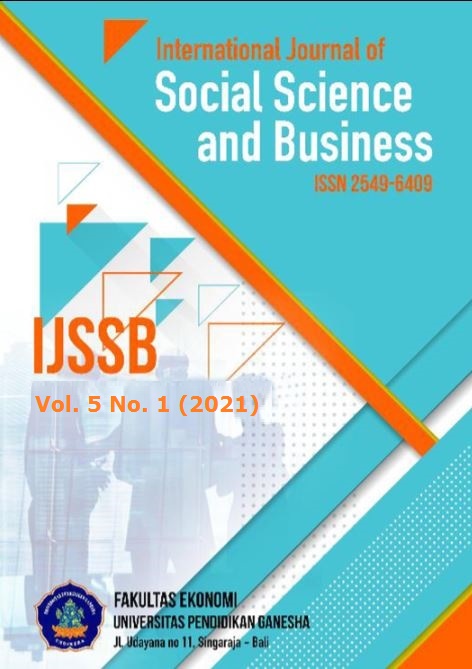Price Discount Framing: How it Can Increase the Purchase Intention?
DOI:
https://doi.org/10.23887/ijssb.v5i1.30533Keywords:
Price Discount Framing, Purchase Intention, GenderAbstract
The high level of competition makes companies compete to retain and win the market competition, one of the strategies are granting price discounts. This was an experimental study that aims to analyze the differences between males and females' intention for online purchase by given the price discount framing conditions, namely percentage saving and absolute saving. The participants in this study were 80 participants. This study was an experimental study since it involved the symptoms had to be investigated. The design of the study was a 2X2 factorial design. A case questionnaire was used for the data collection. The data were analyzed by using 2-ways ANOVA statistical analysis. The study reveals that (1) there is a difference in online purchase intention between those given the percentage saving condition and those given the absolute saving condition, (2) there is a difference in purchase intention between males and females. The consumers have different assumptions about the two types of discount framing even though they both have the same meaning. This should be a concern for retailers in providing sales promotions, especially for discounts because based on the results of this study it is found that discount framing with absolute savings had a slightly stronger effect on purchase intention than percentage saving.
References
Assauri, S. (2008). Manajeman Produksi dan Operasi. Fakultas Ekonomi Universitas Indonesia.
Baron, R. A., & Byrne, D. (2003). Psikologi Sosial. Erlangga.
Carlos Alberto, G., Myriam, M.-F., I.Viedma-del-Jesús, M., & Aranda, L. A. (2020). The processing of price during purchase decision making: Are there neural differences among prosocial and non-prosocial consumers? Journal of Cleaner Production, 271, 26–48. https://doi.org/https://doi.org/10.1016/j.jclepro.2020.122648.
Choi, G., Kim, J., Sawitri, M. Y., & Lee, S. K. (2020). Ecotourism market segmentation in Bali, Indonesia: Opportunities for implementing REDD+. Land, 9(6), 1–15. https://doi.org/10.3390/LAND9060186.
Choi, L., Lawry, C. A., & Kim, M. (2019). Contextualizing customer organizational citizenship behaviors: The changing nature of value cocreation and customer satisfaction across service settings. Psychology & Marketing, 36, 455–472. https://doi.org/10.1002/mar.21190.
Clow, K. E., & Baack, D. (2014). Integrated Advertising, Promotion, and Marketing Communications. Pearson Education Limited.
Crespo, A. H., & Bosque, I. R. (2008). The Effect Of Innovativeness On The Adoption Of B2C E-Commerce : A Model Based On The Theory Of Planned Behavior. Computer In Human Behavior Journal, 2830–2847. https://doi.org/10.1016/j.chb.2008.04.008.
Curtis, T., Abratt, R., & Rhoades, D. L. (2011). Customer Loyalty, Repurchase and Satisfaction: A Meta-Analytical Review. Journal of Consumer Satisfaction, Dissatisfaction and Complaining Behavior, 24(1), 1–26. https://commons.erau.edu/db-management/18/.
Fakih, M. (2008). Analisis Gender dan Transformasi Sosial. Insistpress.
Faryabi, M., Sadeghzadeh, K., & M Saed. (2012). he Effect of Price Discounts and Store Image on Consumer’s Purchase Intention in Online Shopping Context Case Study: Nokia and HTC. Journal of Business Studies Quarterly, 4(1), 197–205. https://doi.org/10.1.1.653.5017.
Garbarino, E., & Strahilevitz, M. (2004). Gender differences in the perceived risk of buying online and the effects of receiving a site recommendation. Journal of Business Research, 768–775. https://doi.org/10.1016/S0148-2963(02)00363-6.
Gendall, P., Hoek, J., Pope, T. a, & Young, K. (2006). Message Framing Effects on Price Discounting. Journal of Product & Brand Management, 15(7), 458. https://doi.org/10.1108/10610420610712847.
Griffin, J. (2005). Customer Loyalty : Menumbuhkan dan Mempertahankan Kesetiaan Pelanggan. Erlangga.
Imari, S., Permana, honeyta lubis., & Syafrudin, C. (2008). Pengaruh Orientasi Belanja, Kepercayaan Online Dan Pengalaman Pembelian Sebelumnya Terhadap Niat Pembelian Konsumen Secara Online Dengan Perbedaan Gender Sebagai Variabel Pemoderasi. Jurnal Perspektif Manajemen Dan Perbankan, 8(3), 49–70. http://www.jurnal.unsyiah.ac.id/JPMP/article/view/10189.
Kim, D. J., Ferrin, D. L., & Rao, H. R. (2008). A trust-based consumer decision-making model in electronic commerce: The role of trust, perceived risk, and their antecedents. Decision Support Systems, 44(2), 544–564. https://doi.org/10.1016/j.dss.2007.07.001.
Kotler, & Keller. (2012). Manajemen Pemasaran (12th ed.). Erlangga.
McCarthy, E. J., & William, D. P. (2002). Dasar-Dasar Pemasaran (5th ed.). Erlangga.
McKechnie, S., James., D., Ennew, C., & Smith, A. (2012). ffects of Discount Framing in Comparative Price Advertising. European Journal of Marketing, 46(11/12), 1501–1522. https://doi.org/10.1108/03090561211259952.
Meldarianda, R., Lisan, H., & Kristen, U. (2010). Pengaruh store atmosphere terhadap minat beli konsumen pada resort café atmosphere Bandung. Jurnal Bisnis Dan Ekonomi (JBE), 17(2), 97–108. https://www.unisbank.ac.id/ojs/index.php/fe3/article/view/329/213.
Nugraha, B. A. (2013). Persepsi Terhadap Store Atmosphere Dengan Minat Beli Konsumen Di Hypermarket. Cognicia: Jurnal Online Psikologi, 1(2), 515–528. https://doi.org/10.22219/COGNICIA.Vol1.No2.%25p.
Rodgers, S., & Harris, M. A. (2003). Gender and e-commerce: an exploratory study. Journal of Advertising Research, 43(3), 322–329. https://doi.org/10.2501/JAR-43-3-322-329.
Saputri, S. A., Mardani, R. M., & Wahono, B. (2018). Pengaruh Price Book Value (PBV), Price Earning Ratio (PER), Return On Assets (ROA) Terhadap Return Saham. Jurnal Riset Manajemen, 133–149.
Slyke, C. V., Comunale, C. L., & Belanger, F. (2002). Gender differences in perceptions of web-based shopping. Communication of the ACM, 45(8), 82–86. https://doi.org/10.1145/545151.545155.
Solihin, D. (2020). Pengaruh Kepercayaan Pelanggan Dan Promosi Terhadap Keputusan Pembelian Konsumen Pada Online Shop Mikaylaku Dengan Minat Beli Sebagai Variabel Intervening. Jurnal MANDIRI: Ilmu Pengetahuan, Seni, Dan Teknologi, 4(1), 38–51. https://doi.org/10.33753/mandiri.v4i1.99.
Solihin, I. (2012). Manajeman Strategik. Erlangga.
Sortino, F. A., & Price, L. N. (1994). Performance Measurement in a Downside Risk Framework. The Journal of Investing. https://doi.org/10.3905/joi.3.3.59.
Wood, M. B. (2009). Perencanaan Pemasaran (B. Monel (ed.); 3rd ed.). PT Indeks.











